
 | Home | Products | Representatives | Resources | SDS | Contact |
| Polywater Support Page |
Combustible Background Well over a decade ago, fires at the Brown's Ferry Nuclear Plant in Alabama and skyscrapers in New York City focused the attention of cable manufacturers and design engineers on the spread of fire through cabling systems. Today's fire-retardant cables are made from specially-formulated, fire-resistant materials. They are tested to special industry specifications. These state-of-the-art, fire-retardant cables show little tendency to ignite and propagate flame, and, thus, do not support the spread of fire. It is common practice to specify fire-retardant cables, as well as "fire stop" materials, to prevent flame from spreading through electrical penetrations in fire-resistant walls, etc. The prevention of fire spread is addressed in the National Electrical Code (Sec. 300-21), as well as numerous building codes and industrial standards. Prevention of flame spread is also desirable for cable pulling compound residue, since they, too, can be present throughout a conduit system. Cable Pulling Compounds Once the cable is installed, the lubricant (or actually the dried lubricant residue) remains dispersed throughout the conduit. Actual quantities of lubricant depend on pull difficulty, pull length, and conduit size. As little as one quart or as much as five gallons could be present in a conduit system. Pulling Lubricant Combustibility Originally designed to test flammability of cables, the IEEE 383 vertical flame tray test was modified to evaluate lubricants. These flame-tray-type tests often produced questionable results. The wax-based lubricants would melt and drip down the cable and into the flame. This was obviously quite different from what would happen in a conduit. Even with the limitations of flame tray testing, American Polywater's High-Performance Cable Lubricant, Polywater® J, showed superior combustion resistance. This flame resistance, combined with an inherently low coefficient of friction and universal cable compatibility, resulted in the extensive specification and use of Polywater® J in nuclear electrical construction. Research on Lubricant Fire Parameters The paper, entitled "Fire Parameters and Combustion Properties of Cable Pulling Compound Residues," showed significant differences in lubricant residue combustibility. "Wax-type" lubricants were found to melt, ignite easily, burn vigorously, and carry flame throughout a conduit. Click here to view a short Video of Wax Lubricant Residue Ignition. Certain other "polymer" lubes also ignited, burnt, and spread flame. Only one lubricant tested was significantly less combustible than a fire-retardant cable jacket control sample. That lubricant was Polywater® J. Click here to view a short Video of Polywater J Flame Resistance. (Note that new Polywater® LZ for LSZH/LSHF cables also passes this flame tray test.) Research Synopsis Testing Method Lubricants Evaluated Combustion-Resistant, Proprietary Formula Wax/Wax-Soap Types Polymer/Water Types A fire-retardant, Hypalon® cable jacket, which meets requirements of the IEEE 383 vertical flame tray test, was used as a control during the tests. Ignition
Cable Pulling Lubricant
Residue Can Spread Fire!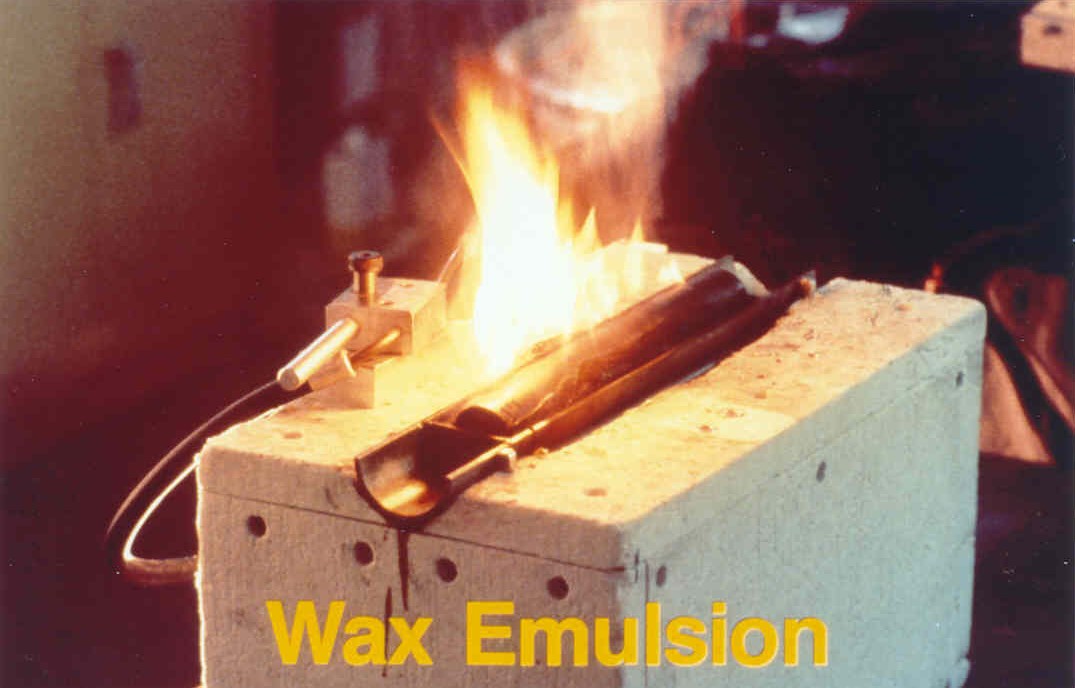
Cable pulling compounds (lubricants) reduce tension on cable as it's installed. In use, the lubricant is liberally applied to the cable jacket and/or conduit inner walls.
Until recently, the fire parameters of cable lubricants had not been extensively studied. Only the nuclear industry has done any testing, initiated in part by a Nuclear Regulatory Commission finding that a combustible wax residue in a conduit could be a deficiency if it negated the flame suppression effectiveness of the cable.
At an International Wire & Cable Symposium, a research paper presented some startling new data on cable lubricant residue combustibility.
The research done on cable lubricant combustibility is summarized below. Copies of the full paper are available on request. This subject is also covered in our free streaming video, Cable Installation Engineering.
The lubricant residue samples were tested in a piece of split metal conduit (blocked at both ends). A flow meter was used to control the volume of gas burnt beneath the conduit. Fires of varying intensities could be simulated with this method. Observations of ignition, time to ignition, flame spread, and burn time were made with and without a continued external heat flux. The evaluation procedure was developed by Factory Mutual in Norwood, Massachusetts, and used in testing cable jackets.¹
Only commercially available lubricants were evaluated. Among these were:
Polywater® J from American Polywater
Yellow 77® from Ideal Industries
Green 80® from Greenlee Tool
Wire Lube® from Ideal Industries
Fast Draw® from Blackburn Division of FL Industries
Wire Pull® from MAC Products
Quick Slip® from Buchanan
CRC® Wire Pulling Lube from CRC
Poly-X® from American Colloid
The heating time required for a sample to ignite, with a pilot flame, was measured at three heat flux rates. Data is shown in Figures 1, 2 and 3.
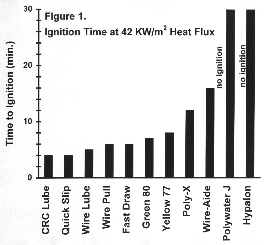 |
 |
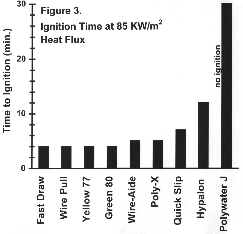 Heat flux represents the intensity of the outside fire source. As reference, the temperature of the inner wall of the conduit after one-half hour was roughly 570° (300°) at the 42 KW/m² heat flux, 670° (350°) at the 61 KW/m² heat flux, and 750° (400°) at the 85 KW/m² heat flux. These are common temperatures in any significant fire.
Heat flux represents the intensity of the outside fire source. As reference, the temperature of the inner wall of the conduit after one-half hour was roughly 570° (300°) at the 42 KW/m² heat flux, 670° (350°) at the 61 KW/m² heat flux, and 750° (400°) at the 85 KW/m² heat flux. These are common temperatures in any significant fire.
Note that a majority of the samples would ignite and burn. The only samples which did not ignite were Polywater® J and the Hypalon® cable jacket control at the lower heat flux, and Polywater® J at the highest heat flux. We gain more perspective on this data by looking at the samples' burning behavior once ignited.
Burn Times
Once a sample had ignited, the time that it continued to flame was measured. Samples would eventually burn out for one of two reasons: they were not very combustible and would self-extinguish, or they would consume all of the available fuel. Data on burn times is presented in Figures 4 thru 6.
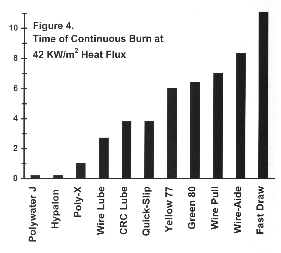 |
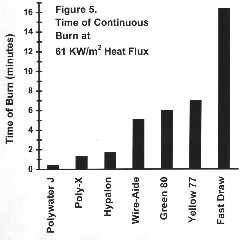 |
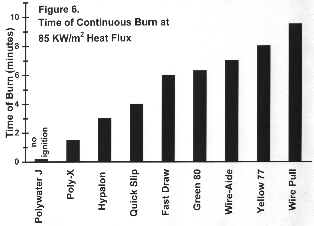 All but a few of the samples burned for significant periods. Polywater® J, the only time it did ignite (at the 61 KW/m² heat flux), self-extinguished in less than 30 seconds. The Hypalon® jacket control also showed short burn times; however, they were considerably longer than the Polywater® J burn times.
All but a few of the samples burned for significant periods. Polywater® J, the only time it did ignite (at the 61 KW/m² heat flux), self-extinguished in less than 30 seconds. The Hypalon® jacket control also showed short burn times; however, they were considerably longer than the Polywater® J burn times.
Additional experiments showed that the burn character of the wax or polymer lube residues was not dependent on the continued presence of a heat flux. Once ignited, the combustion produced sufficient heat to support itself. Most cable flammability specifications determine if and when a burning cable extinguishes, and how far the flame progressed during the burn. The ability to "self-extinguish" is a key feature of fire-retardant cable, and should be equally important in a "flame-retardant" lubricant.
Flame Spread
When samples burned for lengthy periods, they did so because the flame would spread from the point of ignition throughout the whole sample. The observations on flame spread are in Table 1 below.
| Flame Propagation at Various Fluxes | |||
|---|---|---|---|
Lubricant | Flame Spread @42 KW/m²? |
Flame Spread @61 KW/m²? | Flame Spread @85 KW/m²? |
| Polywater® J | No | No | No |
| Yellow 77® | Yes | Yes | Yes |
| Fast Draw® | Yes | Yes | Yes |
| Wire Pull® | Yes | NT | Yes |
| Quick Slip® | Yes | NT | Yes |
| Wire Lube® | Yes | NT | NT |
| CRC® Lube | Yes | NT | NT |
| Green 80® | Yes | Yes | Yes |
| Poly-X® | Yes | Yes | Yes |
| Hypalon® Cable Jacket Control |
No | No | No |
| NT = Not tested because insufficient sample available. | |||
| Note that the wax, wax/soap, and higher solids "polymer" lubes all spread the flame. Polywater® J and the Hypalon® control did not. | |||
Conclusions
All of the wax, wax/soap, and polymer-type lubricants tested had residues significantly more combustible then fire-retardant cable jacket. Only one lubricant tested, Polywater® J, showed little tendency to burn or spread fire. Polywater® J was less combustible than the fire-retardant cable jacket control! (Note that new Polywater® LZ for LSZH/LSHF cables is also less combustible.)
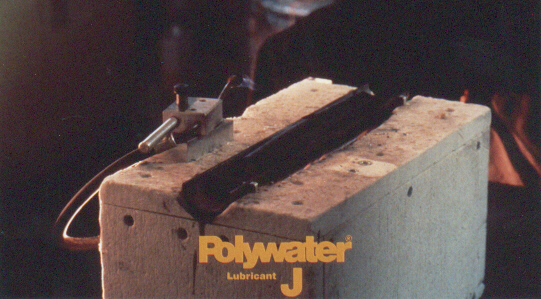
Recommendations
Where the spread of fire is concern, and when fire-retardant cable is placed in conduit, the presence of cable pulling compound residue should not negate the fire suppression effectiveness of the cable. Lubricants that are less combustible than the cable itself, such as Polywater® Lubricant J, should be specified.
Lubricant fire parameters can only be determined by testing. Tests and performance specifications for lubricant residues should include ignition, burn time, and flame propagation character.
Suggested Specifications Are:
1. See "A Laboratory-Scale Test Method for the Measurement of Flammability Parameters"
by A. Tewarson and R. Pion, Factory Mutual Research, Norwood, Massachusetts, Technical Report 22524.

Address: 11222 60th Street N, Stillwater, MN 55082, USA Phone: +1 651 430-2270 | Fax: +1 651 430-3634 | Phone: 800 328-9384 (Toll-Free USA/Canada) General Email: Email Contact Page |